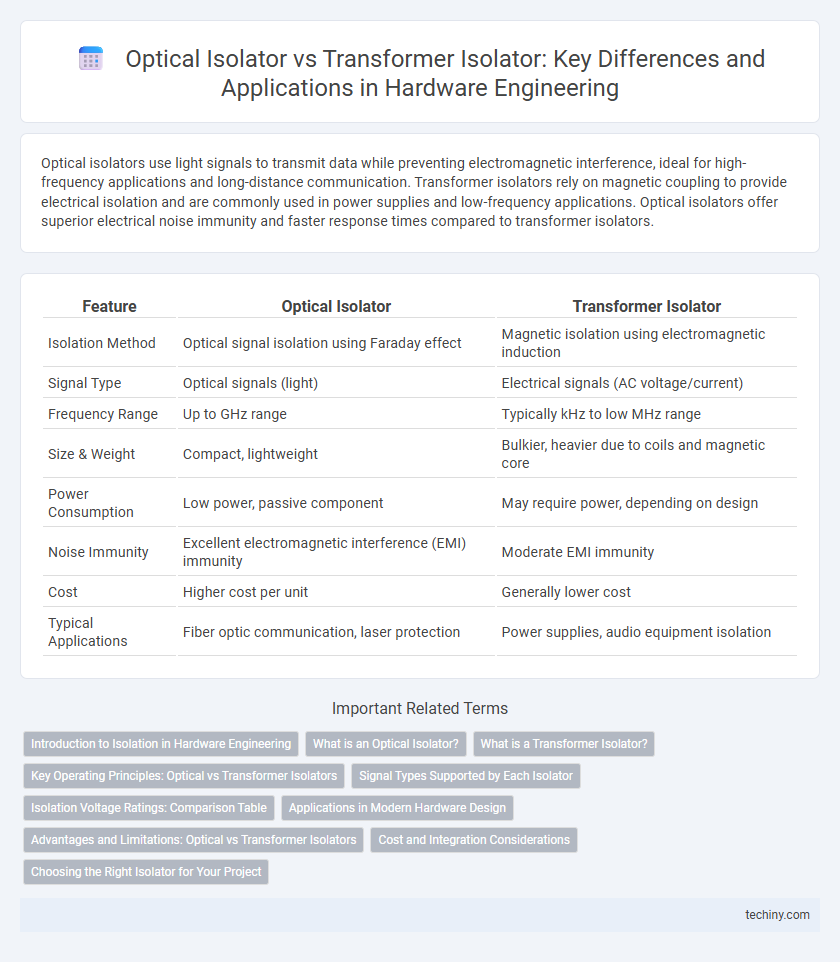Optical isolators use light signals to transmit data while preventing electromagnetic interference, ideal for high-frequency applications and long-distance communication. Transformer isolators rely on magnetic coupling to provide electrical isolation and are commonly used in power supplies and low-frequency applications. Optical isolators offer superior electrical noise immunity and faster response times compared to transformer isolators.
Table of Comparison
| Feature | Optical Isolator | Transformer Isolator |
|---|---|---|
| Isolation Method | Optical signal isolation using Faraday effect | Magnetic isolation using electromagnetic induction |
| Signal Type | Optical signals (light) | Electrical signals (AC voltage/current) |
| Frequency Range | Up to GHz range | Typically kHz to low MHz range |
| Size & Weight | Compact, lightweight | Bulkier, heavier due to coils and magnetic core |
| Power Consumption | Low power, passive component | May require power, depending on design |
| Noise Immunity | Excellent electromagnetic interference (EMI) immunity | Moderate EMI immunity |
| Cost | Higher cost per unit | Generally lower cost |
| Typical Applications | Fiber optic communication, laser protection | Power supplies, audio equipment isolation |
Introduction to Isolation in Hardware Engineering
Optical isolators use light to transmit signals between components, providing electrical isolation and preventing back reflections in hardware systems. Transformer isolators rely on electromagnetic induction to transfer energy, offering isolation by separating input and output windings to block direct current paths. Both methods enhance signal integrity and safety by minimizing noise and interference in electronic circuits.
What is an Optical Isolator?
An optical isolator is a non-reciprocal device used in hardware engineering to allow light to pass in one direction while blocking it in the reverse direction, protecting sensitive components from back reflections and feedback. Unlike transformer isolators, which use electromagnetic induction to isolate electrical signals, optical isolators operate using the Faraday effect, manipulating the polarization of light to achieve isolation. This makes optical isolators essential in laser systems, fiber-optic communications, and precision measurement instruments to ensure signal integrity and system stability.
What is a Transformer Isolator?
A transformer isolator is an electrical device that provides galvanic isolation between its input and output by using electromagnetic induction through a magnetic core, preventing direct electrical connection while allowing signal or power transfer. It enables voltage transformation and isolation to protect circuits from voltage spikes, noise, and ground loops, which is critical in hardware engineering for ensuring system stability and safety. Unlike optical isolators that use light signals for isolation, transformer isolators rely solely on magnetic coupling, making them ideal for AC power isolation and signal conditioning applications.
Key Operating Principles: Optical vs Transformer Isolators
Optical isolators use the Faraday effect to allow light to travel in only one direction, preventing back reflections in fiber optic communication systems by rotating the polarization of light. Transformer isolators rely on magnetic coupling and inductive isolation, using coils and magnetic cores to transfer electrical signals while blocking unwanted noise and interference. The non-contact, magneto-optic principle in optical isolators provides superior isolation performance, especially in high-frequency and sensitive signal applications compared to transformer isolators.
Signal Types Supported by Each Isolator
Optical isolators primarily support high-frequency optical signals by allowing light transmission in one direction while blocking back reflections, ideal for fiber optic communication systems. Transformer isolators accommodate electrical signals, especially AC and pulsed electrical waveforms, by providing galvanic isolation without direct electrical connection. Optical isolators excel in isolating optical signals, whereas transformer isolators are tailored for electrical signal isolation in power and electronic circuits.
Isolation Voltage Ratings: Comparison Table
Optical isolators typically provide isolation voltage ratings ranging from 1,500 V to 5,000 V, using light to achieve electrical isolation without direct contact. Transformer isolators offer higher isolation voltage ratings, frequently between 3,000 V and 10,000 V, by magnetically coupling signals through windings. Comparison tables highlight that while transformer isolators excel in high voltage endurance, optical isolators offer superior noise immunity and faster signal transfer in sensitive hardware engineering applications.
Applications in Modern Hardware Design
Optical isolators are extensively utilized in fiber optic communication systems to prevent back reflections and signal interference, ensuring data integrity in high-speed networks. Transformer isolators are predominantly applied in power management circuits to provide galvanic isolation, enhancing safety and noise reduction in sensitive electronic devices. Modern hardware design leverages optical isolators for high-frequency signal isolation and transformer isolators for robust power isolation in industrial automation and medical equipment.
Advantages and Limitations: Optical vs Transformer Isolators
Optical isolators provide superior high-frequency signal isolation with minimal signal distortion and immunity to electromagnetic interference, making them ideal for high-speed communication and sensitive measurement systems. Transformer isolators excel in power isolation and can handle higher power levels but suffer from size constraints, core saturation, and limited bandwidth, particularly at high frequencies. While optical isolators offer faster response and electrical noise immunity, their cost and complexity are higher compared to the relatively simpler and cost-effective transformer isolators used in power electronics.
Cost and Integration Considerations
Optical isolators typically cost more than transformer isolators due to their complex photonic components and precision alignment requirements, making them less favorable for budget-sensitive projects. Transformer isolators offer easier integration with existing PCB layouts and standard electronic circuits, reducing overall design complexity and production costs. Cost-effective transformer isolators also provide robust isolation for low-frequency applications, whereas optical isolators excel in high-frequency, noise-sensitive environments at a higher price point.
Choosing the Right Isolator for Your Project
Selecting the right isolator in hardware engineering hinges on application-specific requirements such as signal integrity, frequency range, and voltage levels. Optical isolators provide superior noise immunity and high-frequency performance by using light to transmit signals without electrical contact, making them ideal for sensitive analog and digital circuits. Transformer isolators excel in power isolation and handling high voltages, offering galvanic isolation and protection in power supply designs, though they may introduce bandwidth limitations and signal distortion.
Optical isolator vs Transformer isolator Infographic

 techiny.com
techiny.com